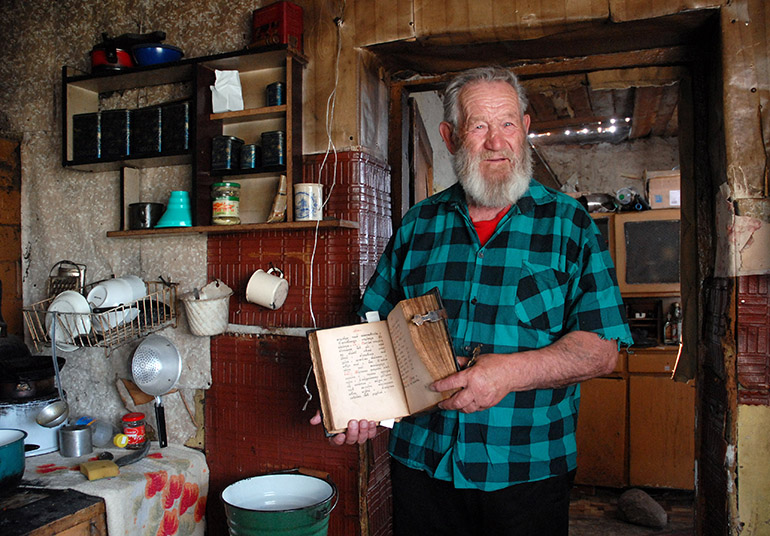Old Ritualists became famous for their solid and resourceful characters, as they followed the principle that honestly acquired and properly used property cannot be sinful. This is how Jędrzej Giertych wrote about the Raskolniks in inter-war Prussia, already part of the Third Reich at the time:
The Russian colonies ( …) are spoken of across all of Mazury, all of East Prussia, and even in Germany. Tourists arrive there from across the entire Reich, in order to see the "russische Dörfer". The money made from tourism makes a significant contribution to the colonists' wealth. The German popular interest in the Russen, who are treated like a touristic oddity, has even resulted in a strange thing: ( …) their ethnic separateness is not persecuted within the ordinary German system, but it is treated with kindness, and even supported.
Early in the 20th century, many Old Ritualists were perceived as Germans of the Old Slavic faith, and after the war they often shared the fates of their evangelical neighbours from the Mazury region, and left, resettling in West Germany. In the Suwalszczyzna region, many took up the Soviet proposal for resettlement and moved to Lithuania, which was annexed into the USSR.
Spiritual and laymen's life
 Tryfon Persyanov, an Old Ritualist, Hołny Wolmera in the Suwalszczyzna region, June 9th, 2008, photo: Andrzej Sidor / Forum
Tryfon Persyanov, an Old Ritualist, Hołny Wolmera in the Suwalszczyzna region, June 9th, 2008, photo: Andrzej Sidor / ForumDifferences in religious belief among the Old Ritualists also led to the surfacing of separate groups. The main dividing line was a conflict to do with the so-called popovtsy and bezpopovtsy. The popovtsy Orthodox priests had no one to administer the sacrament of priesthood, as the only bishop who sided with the Old Ritualists was soon burned at the stake. One group within the Old Ritualists, which was attached to the sacraments, decided to recruit churchmen from a milieu of orthodox clergy, with a new ceremony of baptism. The more radical ones among them broke with the church hierarchy altogether, believing that Christ himself was the only way to salvation, and not the corrupt priesthood. The vast majority of the Polish Old Ritualists are the latter bezpopovtsy ('bez' signifying without, as those who decided to part with the popovtsy priests).
The bezpopovtsy gather in religious communities under the guidance of a nastavnik, a democratically elected spiritual leader. A nastavnik bestows the two sacraments preserved by the bezpopovtsy: baptism and confession, albeit done in a group. He also celebrates marriage, serves at funerals and is the only one allowed to read aloud from the Gospels during mass. He is required to be in impeccable standing in the local community and also know Old Church Slavonic, the language of bezpopovtsy's religious books. This is due to the fact that Old Ritualists only ever acknowledge those religious books which were created before the reforms, or faithful copies of them.
The house of prayer of the Old Believers is called a molenna. Its architecture very much resembles that of Greek Orthodox churches. To date, there are four active molennas on Polish territory, three of which are located in the Suwalszczyzna region: Gabowe Grądy, Suwałki and Wodziłki. Wojnowo, the fourth molenna location, is a village within the region of Mazury to the south-west of Suwalszczyzna. The molenna in Wojnowo is an architectural rarity, as the only brick structure of its kind. It was built as a copy of a Protestant church in the neo-Gothic style. Wojnowo, once an important centre of the bezpopovtsy community, is also home to a 19th-century monastery. With the death of its last nun, it ceased to serve its religious function in 2006, and has since opened to tourists.
Connoisseurs consider the Old Ritualists’ icons to be among the most beautiful. Their cult is very important, as the Old Ritualists believe that they reflect the image of God on Earth. The only worshipped icons are those which have been created in accordance with the old pre-reform canon (while the Orthodox church is known to have drawn on various elements of Western religious art). The icons of the Old Ritualists can only be inscribed on wood, and cannot be either hanged or nailed. Nails were associated by the Old Ritualists with the martyrdom suffered by Christ as he was nailed to the cross, while the act of hanging was an echo of the knots with which Judas took his own life. The writing of the icons itself not only required mastering the skills, but also ascetic preparations, filled with prayer and fasting. A very rich collection of Old Ritualist icons is on display at the Museum of Icons in Supraśl and the Museum of Warmia and Mazury in Olsztyn.
The Old Ritualists were also known for their pursuit of a very severe lifestyle. They were once forbidden to smoke tobacco and abuse alcohol, and they also could not drink tea. For a long time, they lived in isolation from neighbouring faiths, and inter-religious marriages were forbidden. Three to four times a week, they also used to observe periods of fasting, during which they did not eat meat, eggs, or dairy.
The old prohibitions are now often taken with a grain of salt.
This does not mean, however, that the Polish Old Believers have completely broken with their old traditions. The molennas function, as well as various cultural associations, and the Gabowe Grądy village near Augustów continually hosts performances by the Riabina folk music group, who have performed old Russian songs and dances since 1988.
Author: Patryk Zakrzewski, March 2015
Translated by Paulina Schlosser, 07/04/2015
Patryk Zakrzewski used the following sources:
- E. Iwaniec - Z dziejów staroobrzędowców na ziemiach polskich XVII-XX w, (From the History of Old Ritualists on Polish Territory, 17th-20th century) Warsaw 1977
- I. Grek-Pabisowa - Staroobrzędowcy (The Old Ritualists), Warsaw, 1999
- http://www.philipponia.republika.pl/index.htm